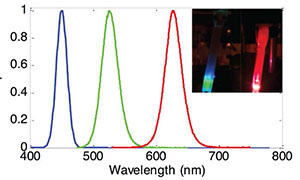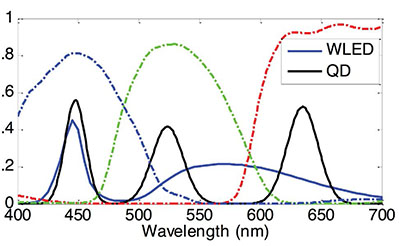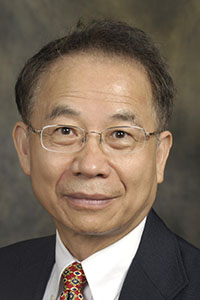The liquid crystal display (LCD) has become ubiquitous and indispensable in our daily life. It is widely used in applications such as smart phones, pads, computer screens, TVs, and data projectors. Recently, the LCD is facing competition from the organic light emitting diode (OLED) display, especially in smart phones. LCDs advantage lie in their low cost, low power consumption, and high resolution density, but lags behind the OLED in the response time, color saturation, and flexibility. To achieve fast response time, Prof. Shin-Tson Wu’s group has developed a new polymer-stabilized blue phase LCD. In the voltage-off state, the blue phase liquid crystal is optically isotropic so that it does not require surface alignment. This greatly simplifies the manufacturing process. In the voltage-on state, the isotropic-to-anisotropic transition induced by the Kerr effect takes place. Its response time is in the sub-millisecond range, which is approximately 20 times faster than that of nematic liquid crystals. The major problem of polymer-stabilized blue phase LCD is its relatively high operation voltage (~50V). Wu’s group has invented a novel protrusion electrode approach that significantly lowers the operation voltage to below 10V. This approach has now been widely adopted by display industry.
Conventional LCDs utilize a white lightemitting-diode (WLED) as backlight because of its excellent efficacy. This white light is produced by using a high-brightness blue LED to pump yellow phosphor. However, the emission spectrum is quite broad (see figure below). The yellow light leaks through the green and red color filters and degrades the color purity. As a result, the displayed color is not saturated and its color gamut is only about 75% of Adobe RGB (see figure below). By contrast, OLED can achieve 100% color gamut.

To obtain vivid colors for LCDs while keeping the optical efficiency high, Wu’s group is designing quantum dot (QD) enhanced backlight with matched spectra to color filters. They have developed the first model to systematically optimize the system. Quantum dots are semiconductor nanocrystals with diameter around 2–10 nm. Quantum dots exhibit several attractive features, resulting from quantum confinement, for display applications: high quantum efficiency, broad absorption band, narrow emission linewidth, and controllable emission peak. The FWHM of QD emission is approximately 30 nm, which is much narrower than that of phosphors. Moreover, the emission wavelength can be tuned by varying the QD size or composition during material synthesis. This offers a new degree of freedom for achieving saturated colors. To achieve white light, a blue LED is used to excite the green and red quantumdot mixture. Such a white light is mixed by the transmitted blue LED and the downconversion red and green QD emission bands. By tuning the QD emission wavelengths to match the transmission spectra of color filters, QD-enhanced LCD exhibits 118% color gamut and 15% higher optical efficiency than conventional WLED.
The implementation of QD backlight can be cost effective, reliable, and processready. In addition, Wu’s group found another remarkable advantage of using QD-backlit: the sunlight readability is greatly enhanced and color washout is dramatically reduced when viewing an LCD from an off-axis direction. This feature is particularly desirable for mobile display devices. Wu’s group continues to develop novel QD device structures, and extend its applications to emissive quantum-dot LED, color-tunable LED lighting based on quantum dot suspension, tunable color temperature LEDs, and low power liquid display based on quantumdot backlight. The integration of quantum dots with blue phase liquid crystals makes next generation LCDs even more appealing.
Shin-Tson Wu was inducted to the Florida Inventors Hall of Fame this year, and also received the 2014 OSA Esther Hoffman Beller medal. The 2nd edition of his book Fundamentals of Liquid Crystal Devices was published this year This is one of 7 books that he has co-authored.


